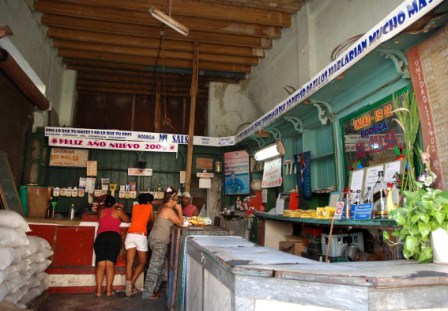We Need More Not Less
Irina Echarry

With her plastic sack under her, Rosa trudges away from the butcher shop after two hours of waiting in line:
“This is crazy! How am I supposed to explain to my granddaughter that somebody has just realized that sausages aren’t nutritious?” she asks herself.
For more than 50 years this food has been both disputed and praised by different sectors of society.
This situation has a perplexing source: the Libreta de abastecimiento or Supply Notebook, (the name given by officialdom and the one most commonly used by people). It is also known as the “Ration Book” (a name given it by some people owing to the few items it supplies and the many it restricts).
At the end of last year, rumors were running rampant concerning the elimination of the ration book, but since it’s now January, it seems it was only that – idle gossip.
The ration book did undergo a few alterations, however.
Salt (remembering that we’re an island surrounded by saltwater) has been again restricted, from around 1kg a month per person (until last year) to a lesser amount per each trimester now according to the number of family members (for example: 1 kg for one or two people, 2 kg for three or four people, etc.).
But what is most unsettling to people (the majority of whom are not vegetarians) has to do with children.
For a long time, with more or less frequency, the State butcher shop provided each person —monthly— only five hot dogs, three-quarters of a pound of soya-burger and a pound of chicken.
Rosa has reasons to be confounded. Her granddaughter is 10 years old and has practically lived off that diet. The hot dogs are the salvation of many parents because they serve as the daily snacks children have to take to school.
This past December, the right to purchase this product for the youngest in homes was eliminated. A note published in the “Tribuna de la Habana” newspaper explained that hot dogs didn’t provide enough nutrition, and therefore kids would instead receive a pound of beef hamburger monthly. “Great!” – thought many people (also non-vegetarians), “The State is concerned about the proper nutrition of children.”
But Rosa knows that with only a pound of hamburger, she won’t have enough for her granddaughter for the whole month. She’ll no longer be able to give the girl hot dogs for her snack, and instead will have to buy chicken at the “dollar grocery” after exchanging her retirement money (paid in Cuban pesos) for CUCs (hard currency).
She would do this only occasionally in the past, but now she’ll have to do it more regularly. That’s why she’s worried. I agree with her that what’s needed is not to subtract, but to add.






No, Ole, I did not ‘miss the point’, as I agree with Irina, I just didn’t wrote it down because it would be superfluous.
If you want my opinion on this particular matter, I say that the ‘nutritional issue’ of the meat sausages in the supply/ration book could’ve been solved by simply replacing them with soy sausages, which are tasty enough an far more healthy.
You could’ve been at least polite enough to answer my question.
I like Irina’s diary. Muy Bueno!
Luis, you miss the point with your talk of pounds versus kilograms. This is an obfuscation. The point right before your eyes is the total inability of a ration such as this to provide the Daily nutritional requirements for a growing 10 year old. And there is a profound lack of red meat protein. Man can not live on Boniato and Malanga alone. And especially not a child in her most important growing years.
What kind of measurement system is used in Cuba? The metric or the ‘medieval’ one? Because Irina has written both ‘kilograms’ and ‘pounds’…
I know that Spanish/French/Portuguese ex-colonies eventually changed to the metric system and British ex-colonies kept the pound-inch system, so I’m puzzled every time somebody from HT writes ‘pounds’ or ‘ounces’ in an article!